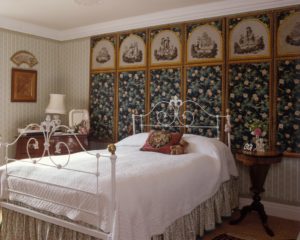A piece of furniture comprising 2-6 panels that is self – standing, folded in zig zag formation when in use, folding flat back on themselves for storage or when not in use.
Pinned flat against the wall antique screens make Great Wall decoration akin to hanging a tapestry.
* Screens can be used as room dividers, window coverings, to hide whatever you might want to cover up, to add scale and to re-balance the proportions of a room.
* I have used them at the ends of beds and sofas, in bathrooms and dressing rooms and even as bedheads.
* A beautiful and delicate antique piece can be pinned to the wall for its own protection and for decoration, perhaps above a sofa, a desk or above a bedhead.
* Easily transportable from house to house and from one life to another; screens are a sensible investment if you lead a nomadic lifestyle or know that this move could be a short one.
* Screens can be solid or framed and made of almost anything, but if they are heavy they should always be secured on one side to a wall or window frame. This is especially important if there is any chance that a small child, an elderly or otherwise generally unstable person might be walking past. A screen will hurt if it falls on you.
* Folding screens can be covered in pretty much anything; any textile from leather, denim, waterproof material, towelling, hemp and faux suede to the most exquisite stamped or embossed leathers and velvets or even include hand painted panels. Soft materials absorb sound, hard ones might resonate or reflect it.
* Solid screens with no textile factor are often made of carved wood, gilded, painted, limed or lacquered, or more elegantly made of metal, glass or perspex that can be etched, moulded or sculpted. Fabric stretched panels can also be set in frames made from any of these materials.
* Options for stretching fabric on framed screens are:
a) within the frame sides, i.e. partially upholstered.
b) onto the front only, or front and back so that an ornate frame remains uncovered and showcases the workmanship.
c) fixed to the sides to completely cover the frame, i.e. fully upholstered.
* The finishing design is crucial to the style. The finish of a fabric, even one as simple as plain wool, will turn a screen into a traditional, classic or contemporary piece. All raw edges other than a felt must be covered by self-fabric strips, braids or studs , that either contrast or complement the main cover.
* Hinges are another major consideration in the design. These can be:
a) made from the same fabric, so that the screen appears seamless and looks the same front and back.
b) full height (piano style) hinges especially made to fit the side of the frame exactly and in metal to suit.
c) three to four decorative hinges placed within the frame or onto the frame–in any case, designed to be seen. Strap hinges can be quite interesting.
d) basic hinges housed into the frame and covered over with the braid or trimming used to cover the sides
e) upholstery nails; but these have raised heads and will prevent the screen folding flat if you need it to.
f ) gate hinges allow the screens to hang onto each other, and can look effective in a barn or building with previous agricultural heritage.
g) flat hinges on top and bottom are invisible and allow each screen to sit against its adjacent side; this creates a very stable room divider, which has no ‘peeking gaps’ and an elegant finish. I think these need to be supported/fixed on one side as they can fall like dominoes if knocked in the wrong place.
* We always prefer to fit screens at one side, to a wall or window frame just to avoid any accident. This can either very discreet or turned into a design feature.

